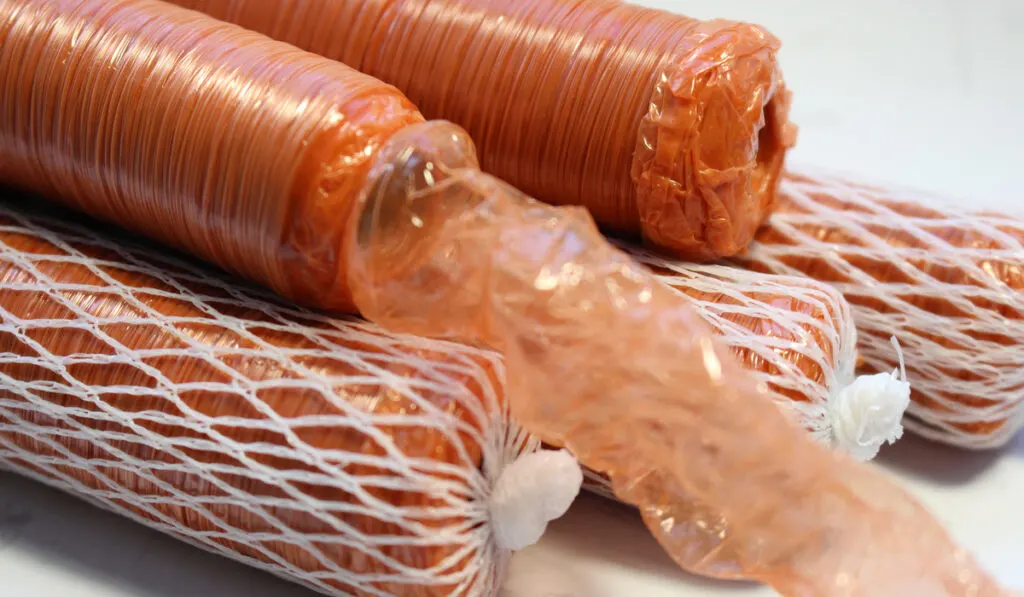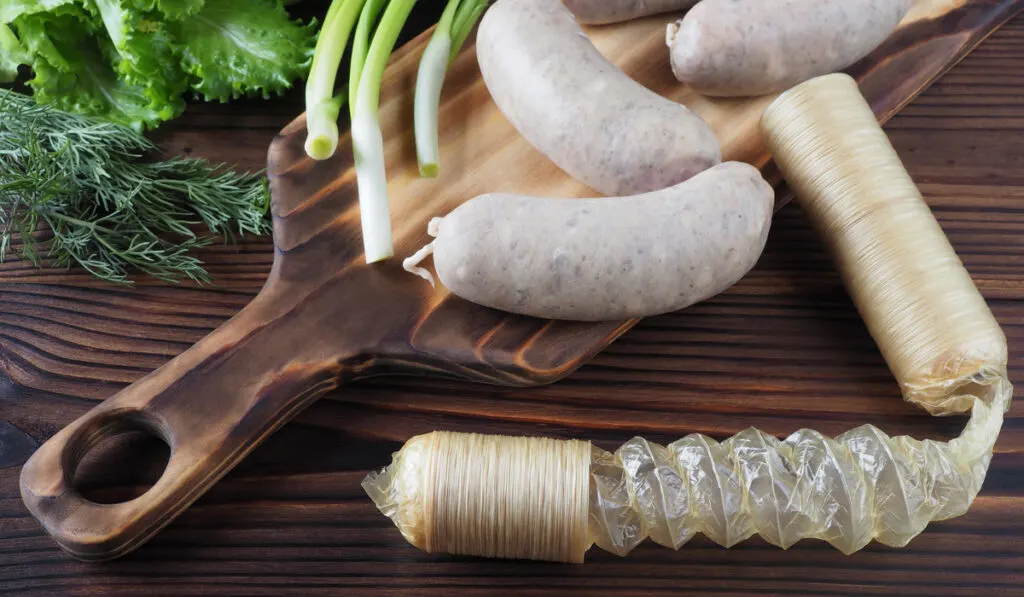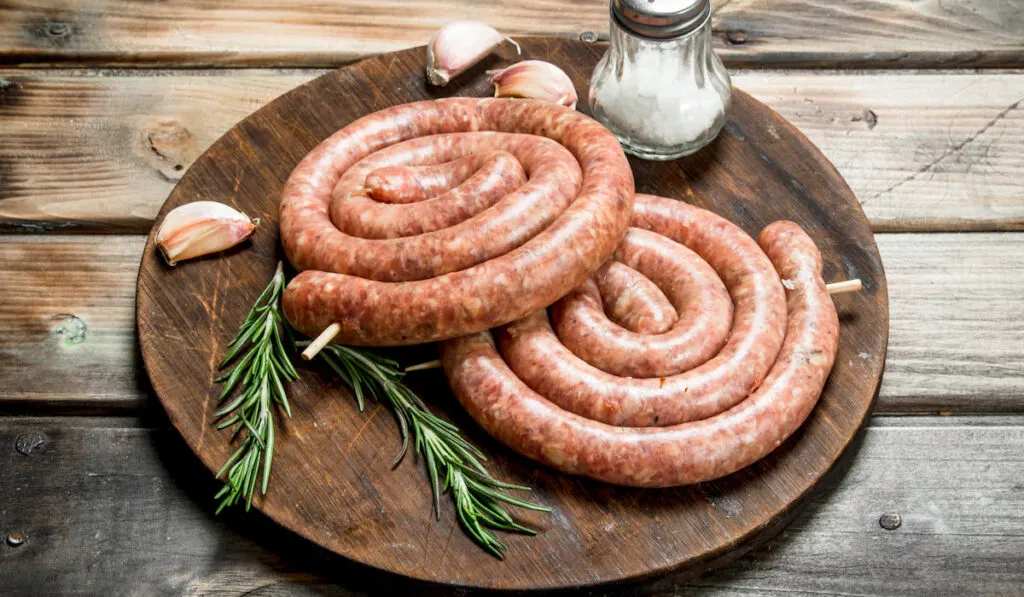Anyone who wants to make sausages at home needs to understand a bit about casings and which types you need for different situations.
Casings come in a few different categories, including collagen, natural, and, cellulose. There are subcategories within these, and you use different ones in different situations.
Texture, flexibility, cost, and usability all affect which casing is used.
Let’s find out a bit more about sausage casings, what kinds there are, and when they are used.
Table of Contents
1. Smoke Casing (Collagen)

Smoked collagen casings are a bit stronger than many of the other kinds of casings, and they are therefore a great option for wieners, hot dogs, and snack sticks. They hold up well in the smokehouse, and they are a good choice if you need a robust casing.
Like other collagen casings, you won’t get as much “snap” from it, but it is inexpensive and does not need to be soaked before you can use it. If you’re looking for cheap and easy, this is a great option.
You can buy mahogany-colored smoke casing or clear.
2. Fresh Casing (Collagen)
The other common kind of collagen casing, fresh casing, is designed for use on fresh sausages – as its name suggests. It is often used for tender meats that are not going to be hung up, and it’s a fairly soft casing.
Like smoked collagen casings, it does not offer much of a snap when you bite into the sausage, but it is cheap and easy to use.
It’s a good option for breakfast sausages and bratwursts. It will often be peeled off before the sausage is consumed (as will smoke casing).
3. Hog Casing (Natural)
A popular choice for many of the traditional sausages, hog casings are used because they – like many natural casings – have an excellent “snap” to them.
They can be used for many different sausages, including kielbasa, smoked Polish sausages, and bratwursts.
All natural sausage casings come preserved in either a saline solution or packed in salt. Both need some processing before you can use them on your sausages. The salt-packed casings tend to take longer to prepare.
You will need to rinse the casing, soak it in cold water, and then run cold water through it.
Next, soak it in warm water for thirty minutes, and then it is ready to use for sausages.
The saline solution-packed brands make for quicker prep; you can just rinse these casings in cold water and then soak them in warm water for thirty minutes. They should then be ready for use.
While they are often more work and more expensive, natural casings have been used for centuries. They have a lot of advantages over collagen and cellulose casings, including:
- They are more flexible
- They are more tender
- They are durable enough for smokehouse processing (which some collagen casings aren’t)
- They are usually easier to stuff
- They can be used for many kinds of sausages
- They have a far better “snap” texture when you bite into the sausage
Natural casings are preferable when you want to make high-quality, very tasty sausages. You do have to put more work and money in, but you get a superior product. This applies to all of the natural casings we are going to list.

4. Beef Casing (Natural)
There are a few different kinds of beef casing, which is another natural sausage casing option.
Firstly, beef bung caps. These are used for large sausages and come from the cow’s large intestine. You might find them useful for making mortadella, bologna (large), and souse sausages.
Next, there are beef middles, which may be removed rather than eaten. These tend to be heavier casings, and they are often used for salami.
Finally, beef rounds, which are low in fat, are a popular choice. However, they are very salty, and will need thorough rinsing and soaking in first cold and then warm water in order to make them edible. Many people soak them in cold water for hours before switching to warm water.
They are particularly good for blood sausages, mettwurst, and ring bologna.
5. Sheep Casing (Natural)
A sheep casing can range in size from around 16 mm to 28 mm, and they are used on the most tender sausages because they are very tender themselves. Because they are quite small, they are limited in their use.
Hot dogs, snack sticks, and breakfast sausages are often made with sheep casing, but any small sausage can use it. If you want a very tender product, sheep casing is a top choice.
6. Cellulose Casing
A casing made from plant cells, this is great for vegan sausages, and some people enjoy it on meat sausages too. You can use it to create a skinless sausage, which many manufacturers are starting to do.
These are usually removed before you consume the sausage – often after it is cooked.
Cellulose casings are made from a tree known as the Abaca, and they are very stretchy. This is obviously a big advantage for creating large sausages, and cellulose casings are versatile.
You can use them for smoked sausages, summer sausages, bologna, pepperoni, and more. They will need to be soaked for around thirty minutes in warm water before being used. As much water as possible should be squeezed out before you stuff the casing.
You can get clear cellulose coatings, or “mahogany.” The mahogany ensures that you get a consistent color across the sausage when it is being smoked. Clear casings may not offer this, so mahogany is certainly a better choice for smoked sausages.

7. Fibrous Casing
Another type of cellulose casing, fibrous is made from cellulose and paper fibers. This kind of casing is strong, making it ideal for being stuffed by a machine rather than by hand. It is good for large sausages and needs to be soaked before use.
Conclusion
If you want to make your own sausages, it’s important to learn about the different casings and how they should be used.
This will ensure your sausages retain their shape and structure, and that they have the right texture when you bite into them.
Resources
- https://www.sciencedirect.com/topics/food-science/sausage-casing
- https://www.psseasoning.com/blogs/news-events/sausage-casings-101
- https://blog.lemproducts.com/selecting-the-right-sausage-casing/
- https://italianbarrel.com/a-beginners-guide-to-sausage-casing/
- https://malabarsuperspice.com/selecting-right-casing-product/
